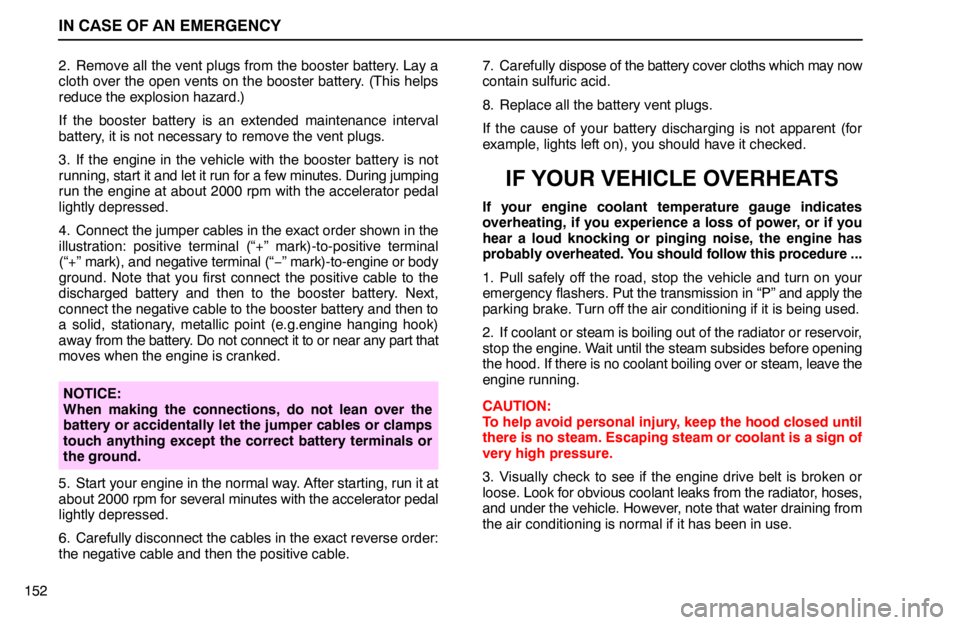charging lexus LS400 1994 Gauges, Meters and Service Reminder Indicators / 1994 LS400: IN CASE OF AN EMERGENCY
[x] Cancel search | Manufacturer: LEXUS, Model Year: 1994, Model line: LS400, Model: Lexus LS400 1994Pages: 17, PDF Size: 6.78 MB
Page 4 of 17

IN CASE OF AN EMERGENCY
1522. Remove all the vent plugs from the booster battery. Lay a
cloth over the open vents on the booster battery. (This helps
reduce the explosion hazard.)
If the booster battery is an extended maintenance interval
battery, it is not necessary to remove the vent plugs.
3. If the engine in the vehicle with the booster battery is not
running, start it and let it run for a few minutes. During jumping
run the engine at about 2000 rpm with the accelerator pedal
lightly depressed.
4. Connect the jumper cables in the exact order shown in the
illustration: positive terminal (“+” mark)-to-positive terminal
(“+” mark), and negative terminal (“−” mark)-to-engine or body
ground. Note that you first connect the positive cable to the
discharged battery and then to the booster battery. Next,
connect the negative cable to the booster battery and then to
a solid, stationary, metallic point (e.g.engine hanging hook)
away from the battery. Do not connect it to or near any part that
moves when the engine is cranked.
NOTICE:
When making the connections, do not lean over the
battery or accidentally let the jumper cables or clamps
touch anything except the correct battery terminals or
the ground.
5. Start your engine in the normal way. After starting, run it at
about 2000 rpm for several minutes with the accelerator pedal
lightly depressed.
6. Carefully disconnect the cables in the exact reverse order:
the negative cable and then the positive cable.7. Carefully dispose of the battery cover cloths which may now
contain sulfuric acid.
8. Replace all the battery vent plugs.
If the cause of your battery discharging is not apparent (for
example, lights left on), you should have it checked.
IF YOUR VEHICLE OVERHEATS
If your engine coolant temperature gauge indicates
overheating, if you experience a loss of power, or if you
hear a loud knocking or pinging noise, the engine has
probably overheated. You should follow this procedure ...
1. Pull safely off the road, stop the vehicle and turn on your
emergency flashers. Put the transmission in “P” and apply the
parking brake. Turn off the air conditioning if it is being used.
2. If coolant or steam is boiling out of the radiator or reservoir,
stop the engine. Wait until the steam subsides before opening
the hood. If there is no coolant boiling over or steam, leave the
engine running.
CAUTION:
To help avoid personal injury, keep the hood closed until
there is no steam. Escaping steam or coolant is a sign of
very high pressure.
3. Visually check to see if the engine drive belt is broken or
loose. Look for obvious coolant leaks from the radiator, hoses,
and under the vehicle. However, note that water draining from
the air conditioning is normal if it has been in use.